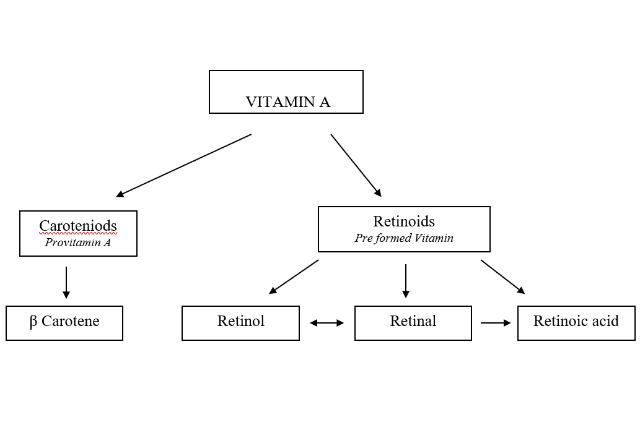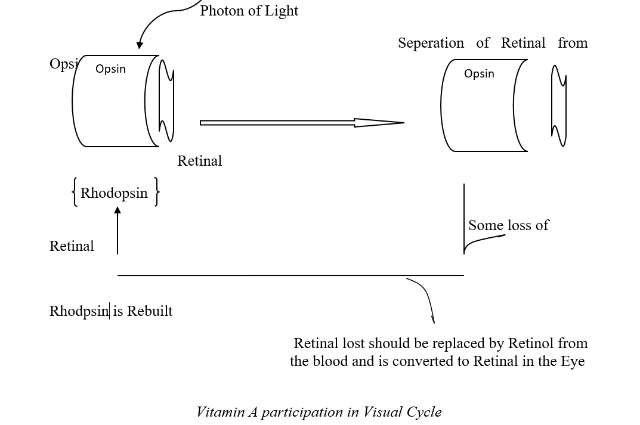
Photo by Hadis Safari on Unsplash
Vitamin A deficiency is the leading cause of blindness across the globe. It is obtained from plant and Animal sources.
The animal source of Vitamin A is referred to as “Retinoids” which is also called as “Pre formed Vitamin” and the plant source of vitamin A is referred to as “caroteniods” also called as “Provitamin A”.
Vitamin A is stable to heat but unstable to light. A small portion is lost while cooking. Deep frying can destroy the vitamin. The drying of fruits under the sun can also destroy a small proportion of it.

The vitamins obtained from plant sources are called carotenoids and due to the yellow to orange pigment present in plants, it is named as "Beta carotene”. Animal source of vitamin A can be available in any of the ‘retinoid form’ such as Retinal, retinol and retinoic acid. Retinal and retinol are interconvertible. Carotenoids from plants have to be converted to retinoid forms for performing the functions of Vitamin A.
FUNCTIONS
- Vision - The primary and peculiar role of Vitamin A is its function in vision. The sensory part of the eye contains Rods and Cones. Cones are responsible for vision where they help in
- Color identification or translated objects into color image in the light/when light strikes the object. Rods are responsible to view the object in the absence of light – to distinguish the color to black and white in the dark.
- Retinal, a form of Vitamin A combines with the protein in the eye, called as opsin forming Rhodopsin.
Retinaldehyde + Opsin Protein (In Eye) Rhodopsin
When light strikes the eye, retinaldehyde is separated from opsin protein and a signal is sent to the hypothalamic portion of brain. During this process, Vitamin A is split from the protein and forms Retinol. Most of this retinol is reconverted to retinaldehyde which in turn combines with Opsin and form Rhodopsin.
This reaction is poor when the person has a deficiency of Vitamin A. The reaction only takes place sufficiently when the diet of a person is sufficient in Vitamin A.

Immune Function:
Vitamin A plays an important role in improving the immunity. The person deprived of Vitamin A can be prone to infections because of reduced immunity.
Health of Epithelial cells:
These cells are present in the outer protective layer of skin and also in the inner layers of skin such as Respiratory tract, urinary tract etc. Mucus is continuously secreted by the cells lining the tracts. The mucus secretion depends on Vitamin A. If sufficient vitamin A is not present, the cells lack mucus leading to dry, hardening of cells which is called ‘Keratinization’. These keratinized cells lack cilia which will trap the foreign particle. If the cells lining the trachea, respiratory tract are keratinized, the bacteria or virus or any foreign particle can invade the body and lead to infection. Thus, vitamin A is responsible in maintaining strong epithelial tissue.
Prevention of Cancer:
Many studies reveal the fact that Vitamin A prevents the onset of cancer at various sites in the body like skin, lung, breast etc. The pigments present in plant origin protects against cancer. Lycopene in tomato, carotenoids especially Beta carotene in yellow and orange fruits and vegetables protects against cancer. More investigation is required to prove the relation between caroteniods and protective activity.
SOURCES
(Indian Food Composition Tables 2017 by National Institute of Nutrition)
| Food Source | β Carotene | Total Carotenoids |
| Drumstick Leaves | 17542 | 38765 |
| Amaranth Leaves | 8553 | 8553 |
| Gogu Leaves | 5285 | 16088 |
| Fenugreek Leaves | 9245 | 12755 |
| Spinach | 2605 | 9553 |
| Carrot | 5423 | 9377 |
| Sweet Potato | 5376 | 8653 |
| Tomato Ripe | 1513 | 5826 |
| Apricot | 1806 | 1806 |
| Dates | 2700 | 3483 |
| Capsicum | 246 | 3047 |
| Papaya | 694 | 2472 |
| Field Beans | 555 | 1738 |
| French Beans | 413 | 1501 |
| Pumpkin | 149 | 1449 |
| Maize | 186 | 1428 |
| Mango | 1168 | 1424 |
| Ladies Finger | 69.10 | 1223 |
| Cluster beans | 241 | 1192 |
| Bengal gram dal | 165 | 1018 |
| Guava | 298 | 996 |
| Peas Dry | 65.71 | 933 |
| Lentil10.29 | 10.29 | 924 |
| Bitter gourd | 122 | 717 |
| Bengal gram dal | 122 | 619 |
Food Source | Retinol Content(µg) |
| Sheep Liver | 14106 |
| Calf Liver | 9664 |
| Pork Liver | 8759 |
| Chicken Liver | 3486 |
| Egg yolk | 456 |
RDA- The RDA for adult man and woman is 700µg of retinol or 5600µg of β carotene/day.
Leafy vegetables, yellow and orange fruits and vegetables such as Pumpkin, papaya, mango, carrot etc are excellent sources of carotenoids. Pulses and lentils are fair sources. Dates and apricots are rich sources. Retinoids are present in animal sources like egg yolk and liver of animals since it is the storage site in animals.
Refined oils and vanaspati are also rich sources as they are fortified with vitamin A. Dark leafy vegetables contain more vitamin A compared to light leafy vegetables. Amaranth, spinach, fenugreek, drumstick leaves are rich sources.
Vitamin A in plant sources is directly proportional to its bright color. The orange pigment called carotene in fruits, vegetables and chlorophyll in leaves resembles the vitamin content. In some fruits like mango, carotene content increases with storage. The brighter the fruit is or the more it ripens, the higher is the content of carotene. The pigment lycopene present in tomato, watermelon and xanthophyll in egg yolk and corn do not have vitamin A value.
In milk, Vitamin A is present in the fat portion. Thus, in low fat milk, the vitamin is absent.
DEFICIENCY
The deficiency of Vitamin A can occur at any stage of life. The symptoms appear when the liver stores of vitamin A are completely depleted. It could be because of low consumption of Vitamin A rich foods, lack of absorption, inability to convert carotene to active form of vitamin A, result of deficiency of protein.
Changes in the Eye – The deficiency of this vitamin can affect the cornea in the early stages where the cornea completely dries up. The tear gland may not be able to produce tears. The cells lining the cornea will be keratinized which eventually rupture cornea. Due to these changes in the cornea the infection sets in and the pus will be released. The dryness of the eye is termed “Xerophthalmia”.
The early symptom is inability to see properly in the dim light termed as “Night Blindness”. Night Blindness is also called as “Nyctalopia”. The next symptom which follows is dryness of conjunctiva called “Conjuctival xerosis”. The conjunctiva loses its shiny luster and is dried off. The next stage is “Bitot’s spots” in which triangular whitish plaques are formed in the eye. They occur as foam and these can be wiped away.
Next follows “Corneal xerosis” in which ulceration and perforation of cornea occur, the ocular contents of the eye are destructed. In the last stage of the disease, keratomalacia, the cornea becomes soft and results in permanent blindness.
